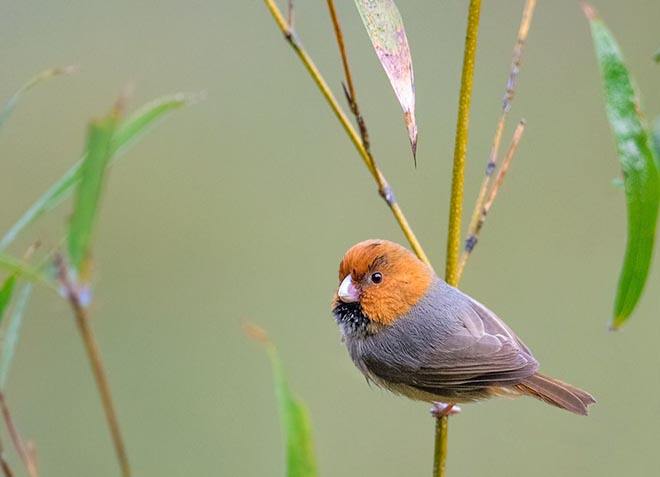Neosuthora davidiana
IUCN
LCBasic Information
Scientific classification
- name:Neosuthora davidiana
- Scientific Name:Neosuthora davidiana,Short-tailed Parrotbill,Paradoxornis davidianus,Hanging mound parrot
- Outline:Songbird
- Family:Passeriformes Oriole Parus
Vital signs
- length:About 9 cm
- Weight:About 10g
- lifetime:No verification information
Feature
The tail is obviously shorter than other crows, and the top of the head to the back of the neck and the sides of the head and neck are chestnut red.
Distribution and Habitat
Distributed in China, northwest Laos, eastern Myanmar, eastern Thailand and Vietnam. In China, it is distributed in Fujian (central and northwest Guadun area), Guangdong and Yunnan (southwest and southeast).
The short-tailed parrotbill mainly lives in understory bushes and bamboo groves in low mountains and hilly areas below 2,000 meters above sea level, and also lives in forest edge bushes. In sparse forest grass slopes and stream banks, there are bushes and tall grasses.
Appearance
Male and female plumage is similar. The forehead, top of the head, nape, back of the neck and sides of the head are chestnut or bright chestnut, the back, shoulders, waist are gray or brownish gray or gray with olive, and the upper tail coverts are chestnut or light brownish yellow. The tail is short, brown or tan, with chestnut or chestnut brown outer edges. The wing coverts are the same color as the back, the flight feathers are brown or dark brown, the outer edge of the outer flight feathers is leathery yellow or yellowish white, and the outer edge of the inner flight feathers gradually turns light brown, and the innermost flight feathers have gray feather edges. The chin and throat are black, some are decorated with fine white vertical stripes or white dots, and the lower throat is sometimes pierced with light yellow horizontal bands. The chest and abdomen are gray with leathery yellow, and the flanks, abdomen and lower tail coverts are light brown or leathery yellow.
The iris i
Details
Short-tailed Parrotbill is a small bird of the Warbler family and Parrotbill genus. It has three subspecies.

The similar species of the Short-tailed Parrotbill, the Orange-fronted Parrotbill (Paradoxornis nipalensis), has a longer tail, an orange-brown head and back, a pure black chin and throat, and almost white underparts. The difference is obvious and it is not difficult to identify in the wild.
The Short-tailed Parrotbill is a resident bird. Except for the breeding period, they move in pairs, and at other times they move in loose groups. They are lively and agile, constantly jumping between the branches and leaves of the undergrowth to find food, often jumping and calling, with a monotonous, soft chirping sound, like "bite, sneeze, bite". They often keep in touch with each other through calls. Sometimes they fly to the top of the tree and chirp constantly, especially when disturbed. They often move in small groups.
The short-tailed thrush mainly feeds on insects and insect larvae, and also eats plant fruits and seeds.
According to Caldwell (1931), a short-tailed thrush nest was found in a bamboo clump about 1 meter above the ground. The nest was made of grass stems, grass leaves, young bamboo leaves and other materials mixed with moss and spider webs, and covered with soft grass stems and fibers.
The global population size of the short-tailed thrush has not been quantified, but the short-tailed thrush is relatively common in China and Vietnam, and is very rare and difficult to observe in other regions (del Hoyo et al., 2007). The population in China is estimated to be about 100-10,000 pairs (Brazil, 2009).
The short-tailed thrush is distributed intermittently in East China to South China, Yunnan and the northeastern part of the Indochina Peninsula. It is an uncommon resident bird. Although it has been reported from time to time in Zhejiang, Jiangxi, Fujian and Guangdong, there is no stable and visible population of the short-tailed thrush in any place, and it is not easy for bird watchers to see it.
In April 2022, during the recent spring bird survey in Danxia Mountain, the bird survey team from the School of Life Sciences of Sun Yat-sen University recorded short-tailed parrotbills on multiple sample lines in Danxia Mountain National Nature Reserve. Some sample lines can see small groups of short-tailed parrotbills in the process of courtship or pairs of short-tailed parrotbills that have just successfully courted several times during a survey. Combined with previous survey records, the head of the expert team said that the distribution area of short-tailed parrotbills in Danxia Mountain is likely to cover the entire reserve. It is a relatively easy-to-see bird in Danxia Mountain and has a large population. This is the first time that groups of short-tailed parrotbills have been observed in Danxia Mountain.
Listed in the IUCN Red List of Threatened Species (IUCN 2016 ver 3.1) - Least Concern (LC).
It has been listed in the "Global Endangered Bird List" by Bird Life International.
It is listed in the "National List of Terrestrial Wildlife with Important Economic and Scientific Research Value" issued by the State Forestry Administration of China on August 1, 2000.
It is listed in the second level of the "National Key Protected Wildlife List of China".
Protect wild animals and eliminate game.
Maintaining ecological balance is everyone's responsibility!








